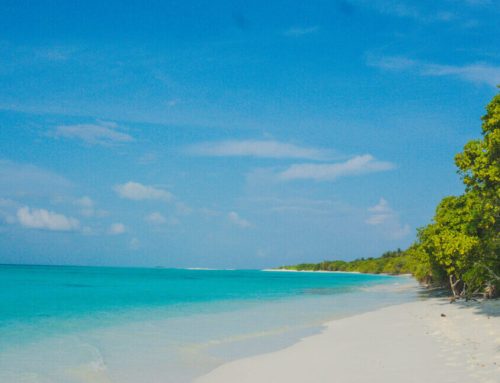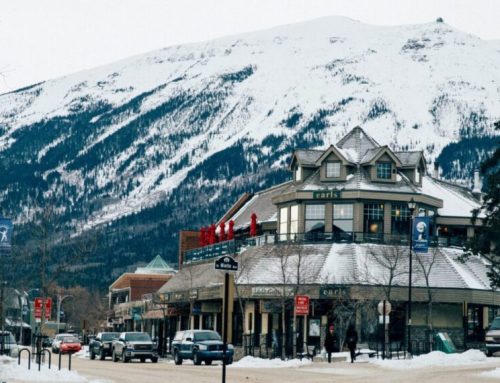Destination Stewardship Report – Spring 2022 (Volume 2, Issue 4)
This post is from the Destination Stewardship Report (Spring 2022, Volume 2, Issue 4), an e-quarterly publication that provides practical information and insights useful to anyone whose work or interests involve improving destination stewardship in a post-pandemic world.
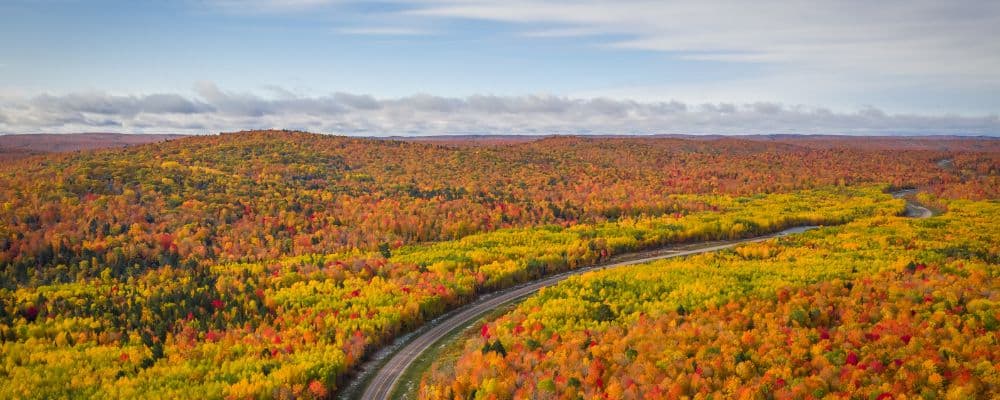
Fall colors along a Big Bay road. All photos courtesy of CREST.
Doing It Better: Big Bay, Michigan
How does a low-population, outdoorsy locale go about convening a destination stewardship council after the extractive industries it once depended on have wound down? CREST’s Kelsey Frenkiel relates how remote Big Bay, Michigan, USA created their own council from scratch. Apparently, a good consultant can help. This is the ninth in the Destination Stewardship Center’s “Doing It Better” series on collaborative destination management in the spirit of GSTC’s Destination Criterion A1.
The Outdoors Unplugged: Building a Destination Stewardship Council on Michigan’s Upper Peninsula
Sven Gonstead came to Big Bay, Michigan, the way most people do: via County Road 550, the 30-mile expanse that links the town, as if by a thread, to the city of Marquette, Michigan. A driver can do a lot in 30 minutes. He can count the shades of gold and auburn that rise as if ablaze in the distance; he can tweak his mind’s radio dial until the static fades and clarity seeps in; he will almost certainly lose GPS signal by about mile marker 20.
For some, the distance is a deterrent. For locals, being at the precipice of one of America’s longest dead-end roads makes their town special. Says Sven, “On that drive was when I decided I was moving to Big Bay.”
Sven is the Chairman of the Big Bay Stewardship Council (BBSC), a non-profit that supports efforts to make Big Bay – a small town located in Powell Township – a wonderful place to live and visit. Sven and other community members, with the help of the Center for Responsible Travel (CREST), built the organization largely from scratch, with many lessons learned along the way.
About the Place
The name Big Bay seems to make an amusing comment on size, with only 800 residents scattered throughout the dense, partial old-growth forest. But what it does not have in population, it makes up for in personality, both culturally and in the natural landscape, with towering trees, booming waterfalls, and abundant wildlife. Its “biggest” asset by far is its location next to 31,000 square miles of Lake Superior; the town counters with almost 2,000 grand, watery acres of its own, interior Lake Independence. Big Bay, and the whole Upper Peninsula for that matter, does not show up on the hand that Michigan residents will raise to depict the shape of the state. The U.P. is a finger that points perpendicular to “downstate” (how UPers – “Yoopers” – refer to the rest of Michigan), and the landmass is actually connected to Wisconsin and nudges into Canada.
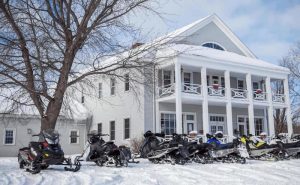
Snowmobiles park at the historic Thunder Bay Inn, seen in the film Anatomy of a Murder.
Some other things Big Bay has to its name: an infamous killing depicted in the black-and-white film Anatomy of a Murder, with two historic locations featured in the story still operating, the Thunder Bay Inn and the Lumberjack Tavern. It was an early vacation getaway for Henry Ford, who owned 313,000 acres of timberland and a sawmill that still looks out over Lake Independence. The town’s bar-goers are also the inspiration for the Big Bay Shuffle, a song and dance coined by actor and musician Jeff Daniels.
Residents can be impressively hardy and capable – entrepreneurs, artists looking for a backcountry muse, and Do It Yourself-ers, some of whom built their own homes or parts of them (sometimes with the intention of going off-grid). They also have a strong sense of community and family, Big Bay being the place where they can spend time with loved ones and truly get away from it all. “Camps,” or rustic dwellings, often without Wi-fi or other amenities, are used as second homes where people can recharge and reconnect with each other
About the Council
The Big Bay Stewardship Council is working hard to protect this unique sense of place, encouraging developments that are good for their micro-economy while also retaining the strength of their cultural and natural environment. This involved, in partnership with CREST, efforts to shepherd more responsible forms of travel. Tourism is already occurring in large numbers. Visitors share Big Bay’s trail systems, stay in short-term rentals or the hotels and motels, use boats and kayaks on the lakes, frequent local campgrounds, and take part in seemingly all types of year-round recreational activities, both motorized and non-motorized.
The BBSC focuses its work around six major goals:
- Enhance Sense of Place
- Expand Outreach & Partnerships
- Support Infrastructure & Asset Enhancement
- Provide Entrepreneurial Support
- Support Authentic Experiences & Events
- Measure What Matters
Organizational Development
Each year, the BBSC conducts planning sessions to determine what activities will be accomplished that year to achieve these goals. They currently have three committees and hope to establish more as they gain capacity: the Steering Committee for overall governance, the Marketing Committee to maintain their partnership with the destination marketing organization Travel Marquette in telling Big Bay’s story, and the Placemaking Committee to conduct on-the-ground projects. The BBSC recently achieved non-profit status through the IRS, which means they can accept tax-deductible donations and apply for grants more easily.
To support this project in the early stages and determine that a destination stewardship council was needed, CREST conducted a scoping study to understand the region’s opportunities and challenges and collected baseline data about the impact visitors were having on the economy, the environment, and resident quality of life. They also helped to develop a marketing brand, Discover Big Bay, with a logo and associated tagline, “the outdoors unplugged.” The Lundin Foundation and Eagle Mine also partnered on the project as part of their work to strengthen communities where they operate.
The initiative has already ticked the first box for sustainable management of tourism destinations, according to the Global Sustainable Tourism Council’s Destination Criterion A1: having “an effective organization, department, group, or committee responsible for a coordinated approach to sustainable tourism, with involvement by the private sector, public sector and civil society.” This type of cross-sector collaboration has been elusive for even the most developed tourism destinations. Sven explains how they got there:
Background
You’re not originally from Big Bay. What prompted you to move there, and what is so special about it?
Long story short, I came to participate in the first Noquemanon Ski Marathon in January of 1998. It was the first time I had spent any amount of time in Marquette County, and I found love. It was incredible. The day after the ski race, I drove County Road 550 from Marquette to Big Bay, and on that drive was when I decided I was moving to Big Bay. It had all the elements I was drawn to on the dead-end road. It was the people that were looking for an alternative to the normal existence in this country, I guess. People that are looking for something a little different… that are looking for more resonance with nature and the water. And of course, I love skiing in the winter. I moved in August 1998.
What is it about Big Bay that keeps people there?
A big part of it is the people. It draws folks that are independent and strong. That think of the world in a different way. And we’re obviously all drawn to the physical beauty. With Big Bay it doesn’t jump out at you right away when you pull in. You will see these places that are amazing after you arrive – Alder Falls, Black Rocks, Yellow Dog Plains, and the Yellow Dog River…. Both [my wife] Marcia and I have so many places we want to visit that we haven’t yet. A lot of hidden morsels.
What are some of the challenges the region faces economically, environmentally, or with tourism or quality of life?
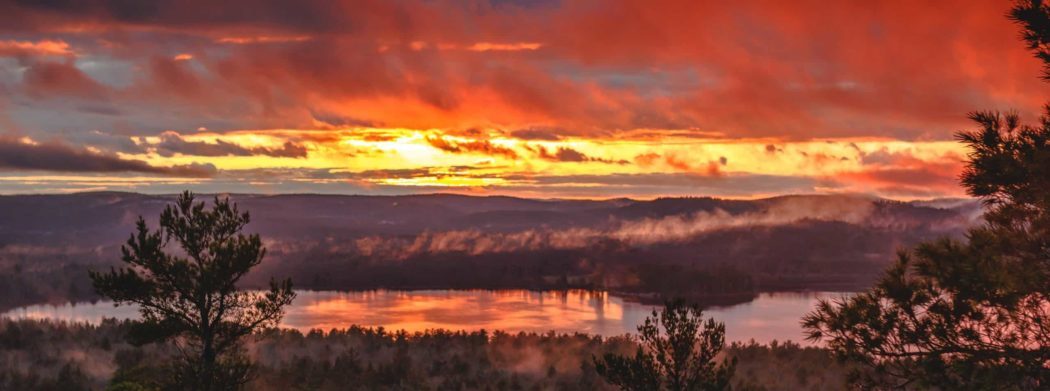
Sunset highlights one of Big Bay’s many lakes.
That’s the ironic thing. A lot of the things that draw folks to Big Bay, they preclude economic development in the usual context. We’re at a dead-end road, it doesn’t really make sense for any manufacturing. It can also be hard to find healthy food in our community. So those things that draw people to Big Bay are the things that can make it difficult to live here. A micro-economy that is successful is a difficult dance. CREST was important in helping us determine that sustainable tourism could help us diversify our micro-economy.
Big Bay was a community that was developed through using natural resources like logging, mining… And some manufacturing thrown in there too. The Ford Mill, the Brunswick Mill. Our roots are in harvesting lumber. There’s a lot of environmental issues that have arisen through the years, and today there are significant threats to our natural and cultural resources. The dichotomy of development in the context of our natural environment is interesting. There’s a prospective spaceport that could be [here] in Powell Township, and of course there are issues environmentally with that. It feels like there is always pressure to keep developing. We have to figure out how to have a micro-economy that’s not going to threaten our way of life. It’s a real challenge to re-tool a little bit and look to the future in different ways.
How Big Bay Built Their Council
How did the Big Bay Stewardship Council get started?
Things got started when a few community members got together and started talking about what this community can do differently that can carry us into the future. As stated earlier Big Bay has been dependent on boom-and-bust industries, like mining. Thankfully, the Lundin Foundation and Eagle Mine recognize that their presence has the potential to initiate that cycle again. Fortunately, they’ve been great partners to help us figure out a way that we can buffer this boom-and-bust cycle that has occurred during the last 100 years. Working with CREST, we completed a scoping study and got some baseline data [such as number of people employed by tourism, trail user counts, and funding raised by existing events] to build off of.
What are some examples of projects that address the above challenges?
An issue is that we didn’t have a conduit for the community to communicate. That was one of the biggest challenges. Folks are doing their own thing, saying, “wouldn’t it be great to do this or do that”. Without a conduit, it was tough to have an organized effort to a) understand what the community wants as a whole and b) determine what it will take to accomplish those goals and c) follow through and finish them out. It’s pretty neat we have the structure [through the Big Bay Stewardship Council] now that we can look to. The Big Bay Fall Fest is a great example. It’s a representation of what the BBSC is all about: bringing in everybody from the community, the artists, the gunsmiths, farmers, non-profits, food vendors, and the people of all ages. It’s about just being together, initiating the conversation, and understanding that we’re in this together.
Tell us about the people of the BBSC. Who do you have on the Council and why?
It’s such a wonderful and diverse group. I’m excited for the future in that regard. The BBSC at its best is intended to be as diverse as possible. We’re doing a good job of that. We have a couple of nonprofits with the Yellow Dog Watershed Preserve, Bay Cliff Health Camp. Then we have for-profit businesses like the Thunder Bay Inn. And local government… It’s incredible to have something new for this community, where we can have a conversation about what’s a sustainable direction that preserves the character of Big Bay.
Accomplishments
What have been some of your greatest successes so far?
This diverse group that’s well-represented. We’re able to really communicate in a way that’s productive.
Another success, with CREST’s assistance, is the scoping study and the baseline data collection that we were able to do. In my opinion, [data collection] is one of the most important things that the BBSC is doing. By keeping tabs on what’s going on, we have a shield against any potential overtourism issues that pop up, to make the right decisions going into the future. We’re armored with this knowledge. It’s becoming more obvious to me how important it is as we progress. I don’t know any neighboring community our size that has the ability to do that right now. To collect resident input, and use that data to inform our activity planning.
And the Fall Fest. It was like a big old barbecue… It was so great to see everyone hanging out. To be able to support other businesses and people that are starting little projects or hobby businesses, to have a platform for them to try it out, even if it’s just a booth at our Fall Fest.
Lessons Learned
What are some of the most important lessons you’ve learned in the 1.5 years that the BBSC has been operating?
First, the importance of data collection. It’s absolutely critical.
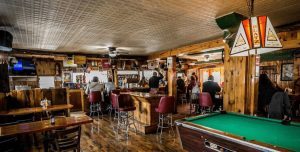
Bar-goers hang out at the historic Lumberjack Tavern.
Second, that we should always be thinking about our capacity and be reasonable [with our activity planning]. We have to always keep in mind what’s achievable. The biggest issue is that making a living in Big Bay… that’s a full-time job in itself. A lot of people have skill sets to help with what is needed to run an organization like this, but a lot of those people are retired. People come here to relax, to get away from it all, to fish and stuff. There’s a limited amount of folks that are willing to help and that can help. It makes it really difficult. But there’s a lot of untapped talent and potential in our community. As we grow and people understand the value [of the BBSC], we’ll see an uptick in membership and volunteer help. We’re thinking about launching a membership model, but we need to do preliminary projects to get people to understand the value of our work first. If they understand that, they’ll jump in.
Being such a diverse group, a community that communicates together is going to see greater results. Other communities did not do as good a job communicating early on and they got overwhelmed [with tourism]. And that is a big lesson for us. With Marquette evolving as a tourism destination and the rate it’s growing, it’s very possible something could happen in Big Bay, and we could get rolled over beyond our capacity. It’s good to have data and communication so we can keep tabs on that and react as needed.
What are you most excited about tackling in the future?
First, working to expand the membership and the volunteer core, and watching the organization grow. It will be a slow but steady process.
I’m also really excited to actually tackle a larger project [like collaborative trail building or installation of streetlights] that we couldn’t begin to consider before the BBSC existed. We didn’t have the structure to even think about the bigger picture and tackle some things that people talked about that would improve our community.
I also think we can support the artists and musicians in our community more. We have many artists here, but there’s not a framework for them in the community. They’re living here but pursuing their work remotely. We hope to find ways to support them, maybe do an artists-in-residence project or gallery to create an environment that’s appealing for artists to live here.
I’m excited to see the Fall Fest grow and evolve.
Finally, I hope we will be able to assist Powell Township with large projects such as improving curb appeal, a community center, and building a Historical Trail. This will be a great opportunity to bring the community together in a way that embraces its past, helps its future, and provides practical improvements for residents and visitors alike.
You can support the Big Bay Stewardship Council by making a donation and following along with their work via their website, bigbaystewardship.org.
About Kelsey Frenkiel
Sustainable tourism, conservation, and sustainability professional; co-editor of Overtourism: Lessons for a Better Future (2021). LinkedIn


